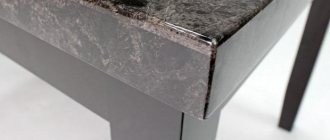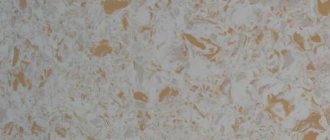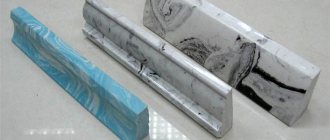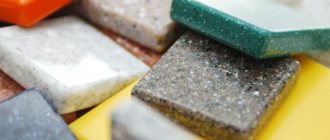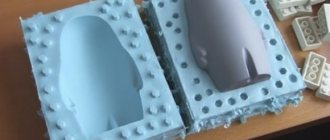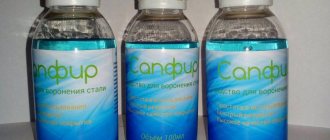Description and types of material
Artificial marble is a decorative and building material that quite accurately imitates natural stone. It is widely used in construction, renovation and industrial applications.
For its production, both mineral components and synthetic resins and other additives are used. Due to the special method of introducing dyes, the surface of the finished product has a characteristic pattern with marble stains and specks.
Artificial marble has many positive characteristics:
- high mechanical strength;
- durability, long period of operation;
- low thermal and electrical conductivity;
- fire safety;
- environmental friendliness, harmlessness;
- resistance to acids, alkalis, fats, moisture;
- aesthetic appearance;
- hardness, ease of processing.
Depending on the production method, artificial marble can be cast, cast, ground or liquid.
Liteva
This composite material is the most popular, since the injection molding method is applicable even at home. The basis of artificial marble is a mineral filler (quartz sand or stone chips) and polyester resin. In industry, plasticizers and other targeted additives are also added to the composition.
Oselkovy
The material is a marble-painted gypsum mass, which is diluted with an adhesive solution. Substances that slow down the setting of gypsum must be added to the composition. Due to grinding and polishing, products made from ashlar marble have a beautiful shine. They turn out durable and lightweight.
Oselok marble slabs
Important! Products made from oselkov marble do not tolerate high humidity.
Ground (microcalcite)
Crushed (ground) marble is a white, grayish powdery material obtained by grinding marble chips. It is used for the production of paints and varnishes, linoleum, and various types of plastic. Finished products are durable and resistant to UV radiation, but their moisture resistance is quite low.
Liquid
The material is produced by combining marble chips and acrylic polymers. It is lightweight, flexible, completely non-toxic and environmentally friendly. Due to their small thickness, sheets of liquid artificial marble can be cut with scissors and used instead of wallpaper. The surface will be smooth, seamless and durable.
Materials for artificial stone
The outer surface of the liquid stone is gelcoat. This is a protective and decorative layer with improved physical and mechanical properties, increased resistance to ultraviolet radiation, moisture and other external influences. Gelcoat is divided into general purpose and special purpose (chemical resistant, fire resistant, matrix, etc.); it can be transparent or colored. Gelcoat is available for application with a brush or for spraying with special sprayers. The gelcoat is cured with ordinary methyl ethyl ketorone peroxide (MEK in common parlance). IEC is represented on the market by the brands Curox and Butanox. To apply gelcoat, we recommend using a Russian-made G-120 manual sprayer. According to the principle of operation, it is an improved analogue of the G-100 sprayer, and at a price of 3000 rubles. cheaper. Additionally, the G-120 can be equipped with gelcoat nozzles with a diameter of 3.5 – 7 mm, which allows you to change the gelcoat flow rate when spraying, as well as spray Granatex and Granicout.
The binder for artificial stone is an unsaturated polyester casting resin on an orthophthalic or isophthalic base. The low viscosity of the resin allows it to be filled with various fillers, both organic and mineral, neutral with respect to polyesters. Marble chips or other mineral filler having a specially selected fractional composition are usually used as fillers for the production of products using artificial stone technology. Increasing the mass of the filler ensures a reduction in the cost of products.
Today there is a very wide choice of manufacturers on the market of composite materials: the USA, Finland, Great Britain, Holland, Turkey, China. Unfortunately, Russian manufacturers produce products of very low quality. All leading manufacturers have their dealers in Russia. This is an already formed market in which supply significantly exceeds demand. Therefore, in order to sell THEIR product, some Russian representatives cunningly offer free technology. This is tantamount to putting a person behind the wheel, giving him the rules of the road, a technical description of the car and wishing him a happy journey. Always remember, free cheese is only in a mousetrap. At the initial stage of organizing production, the most important role is played by the “instructor”, a highly qualified specialist. Which will explain ALL the subtleties and nuances of production technology, help to avoid mistakes and save your time in reaching design capacity. And what’s most interesting is that no one will ever teach you the technique of modeling and constructing matrices, and this is the MOST IMPORTANT thing. And all because it is more profitable to sell you a matrix than to teach you how to make it.
Matrices (casting molds) are the most important part of production using cast stone technology. Unfortunately, there are very few manufacturers of equipment on the Russian market from whom it would be possible to order the required matrix from a catalogue, and its cost would be from 60,000 rubles. An imported matrix from foreign suppliers will cost from $3,000, which is an absolutely “unaffordable” price for a beginning manufacturer. The most correct way is to make the matrices yourself. In addition to saving money, this will also increase your competitive advantage, as it will allow you to quickly respond to market needs and quickly change the range of liquid stone products. And when manufacturing products to order, this is the only possible way to satisfy the customer’s wishes. To make a matrix, you need to know fiberglass technology and modeling techniques for making master, design, conceptual and volumetric models, but unfortunately no one wants to share such knowledge. But not everything is so sad, the Polidek-Profi company will help you in establishing your own casting stone production.
To organize production using cast stone technology, it is enough to rent a small warm room, equip it with a ventilation system, purchase the necessary equipment, matrices for products and the necessary raw materials. All of these components are easy to buy or make. Therefore, if you are looking for opportunities for development, you are interested in new technologies and unusual materials, we draw your attention to cast marble technology, as well as fiberglass technology, so simple and affordable, but still little known in Russia. Everything else will depend only on you.
Production of cast artificial marble
Before starting work, you need to immediately prepare all materials and consumables, as well as buy or rent tools and equipment for marble production.
Equipment
First of all, you need matrices - forms for pouring the marble mixture. Polyurethane molds have proven themselves best - they are very durable and do not deform, although they are not cheap.
Table top mold
You will also need:
- components for mixing the composition;
- construction mixer;
- Sander;
- capacity;
- gelcoat sprayer or mold brushes.
Composition of raw materials
The main components are polyester resin (gelcoat) and marble chips (flour) in a 4:1 ratio. Cement, gypsum, lime, and quartz sand are also used to improve strength and improve performance characteristics.
Important! If desired, cement can completely replace the polyester resin in the composition, but the reliability of the finished marble will decrease.
In this case, the “recipe” for the solution will be as follows:
- sand – 2 parts;
- cement – 1 part;
- small stone chips – 25% of the total volume;
- water – 0.2 parts;
- plasticizer – 1% by weight of cement;
- pigment – 1% by weight of cement.
Production technology
The method of producing artificial marble is simple, it is only important to follow the specified recommendations.
Preparation of the solution
Pour the dry ingredients into a clean container, mix them thoroughly with a mixer and add the dye. The latter is mixed in carefully to maintain the uneven color of the finished material.
Then the mass is diluted with water, shaken well or placed on a vibrating table - this will help get rid of air bubbles. Water is introduced in 2 steps: first, 80% of the liquid is added, then the plasticizer is added, and then the remaining water.
Preparation and filling of forms
The molds are placed in a strictly horizontal position, sprayed with gelcoat (polyester resin), and the solution is poured. Shake to get rid of excess air and leave to harden for at least a day under the film.
Advice! To enhance the strength of marble, reinforcement is made - a wire mesh is placed in the thickness of the solution.
Processing of finished slabs
After curing, the molds are turned over, the stone slabs are taken out and sanding begins. Such products can only be cut with equipment equipped with diamond blades.
Use and care instructions
Artificial marble is often used for decorating rooms and wall cladding. It makes beautiful tabletops, window sills, stairs, sculptures, and decorative fountains. The material is suitable for finishing house facades, emphasizing window and door openings, and creating paving slabs.
Artificial marble should be cleaned with a soft cloth, as hard brushes can leave scratches on it. It is washed using liquid SMS and does not use drying oil-based products for polishing. Otherwise, the material is considered quite unpretentious and, with the right approach, will last for many years.
The procedure for making the mold
In order to start working on making a mold, you need to determine:
- will the matrix be used once or will it be used multiple times. If it is necessary to use the matrix several times, its design must be made collapsible;
- the necessary strength that can be achieved when preparing the mixture;
- view of the front surface. It can be smooth or grooved. Often, the grooved look is suitable for making wall tiles.
A variety of materials can be used to make the matrix; there are no restrictions. The main requirement is the strength of the matrix and ease of working with it. Most often it is created on the basis of gypsum, polyurethane, plastic, and wood. In the event that the matrix is quite large, and the final product must be smaller in size, the mold can be divided into half-molds. Thus, samples of the same type will be produced, and the work will represent mass production.
How to prepare a matrix
To prepare the matrix for sample production, it is necessary to lubricate the internal surface with a lubricant, thus preventing the mixture from sticking to the walls of the matrix. If the resulting marble is planned to be processed in the future, a thin polyethylene film can also be used as a separator. The surface of the sample is lubricated with gel, which gives it the necessary shine.
Preparing the batch
The basic rule used when preparing a batch is to obtain a homogeneous mass. This result can only be achieved by thoroughly mixing all components. To facilitate manual labor, you can use electrical appliances such as a construction mixer or drill.
Pouring the mixture
When the solution is poured into the matrix, it is necessary to remove air from it, which appears in the form of bubbles. It is easier to do this by piercing the solution along the entire perimeter of the matrix. Those who are not producing cast marble for the first time may have already purchased a vibrating table, the operation of which allows you to rid the mixture of air layers.
The rate of hardening of marble depends on the air temperature, the thickness of the load and the components of the mixture. Minimum time 30 minutes, maximum 12 hours. At this stage, it should be remembered that the mass should not be completely poured into the matrix at one time; filling the matrix is carried out in several stages and is accompanied by constant stirring. When the entire mass is loaded, the matrix is covered with a film on top, which prevents cracks from appearing on the sample and prevents moisture from evaporating.
Post-processing
Removal of the sample from the matrix is accompanied by a decision on the need for additional mechanical processing and final polishing.
